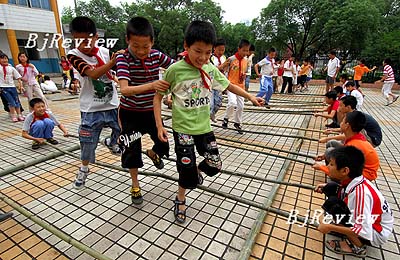|

"Always studying hard in front of a desk which is full of books and exam papers, solemn-looking, no smile, occasionally looking up with a pair of glasses perched on his face." That was the typical image of a high-school student, or even an elementary school student, a couple of years ago in China. Sports were rarely part of the educational picture.
Physical training
In order to change the poor level of physical exercise among students as well as ideas about sports in general, governments at different levels have implemented policies to improve the conditions for sports. The General Administration of Sport of China promulgated a Students' Physical Heath Standard in July 2002 to replace the former one which was failing to fully reflect the health condition of students. The new standard added height and weight among the standards of physical health. In addition, students of different grades were given different sports activities to do. For example, students in grades one and two in elementary schools will have sit-and-reach tests, while students in grades three and four will take part in a 50-m run.
In May 2007 the State Council of China implemented a plan under the slogan "sun sports for 100 million students of China," calling for physical training of at least one hour every day for juveniles with the purpose to encourage students in elementary and middle schools to leave their classrooms to do sport. Schools were ordered to set aside one hour for physical training each day.
Due to exam and homework pressure, one hour every day seems quite luxurious, and demonstrates the government's firm stand in promoting and enhancing the importance of sports activities in elementary and middle schools. Few schools have reached the goal of an hour of sport a day, but things are changing in the right direction.
Chenjinglun Middle School is a key middle school in Beijing. The school reformed its physical training classes in 2003, and PE lessons became a daily class. The contents of the classes changed too. Students no longer all receive the same training, but get to choose an activity according to their interest. There are nine different courses, including ping-pong, basketball, football, badminton and Taekwondo.
"It was quite enjoyable to have PE (physical education) lessons in my middle school," said Yin Yuge, a student who just graduated from Chenjinglun Middle School. He took a course in Taekwondo, which enhanced his confidence level.
Kaifeng High School is a key high school in Henan Province. PE lessons are the first thing to be taken into consideration when making class schedules each new semester. The school makes sports plans for different students according to their own physique. PE classes are the students' favorite, and give them more energy to study.
Compared with urban schools, schools in rural areas are not so lucky, especially those in poorer areas. The China Youth Development Foundation (CYDF) conducted a report on the sports environment in primary schools sponsored by Project Hope in June 2007. The report showed that 80 percent of schools had no qualified PE teachers, and no schools had qualified PE facilities. The findings were a striking contrast to the enthusiasm of students. In light of the report, CYDF made a plan to equip all the schools with qualified sports facilities within three years.
Required standard
There are some standards for college students, especially for fresh and sophomore students who take PE lessons as a compulsory course. If they fail to reach a required standard, students can be denied a scholarship.
For junior and senior students, PE lessons are selective. Students can choose different courses according to their own interest, such as volleyball, boxing, football, basketball and tennis, and most universities have qualified facilities and sports grounds for students. The National College Students' Sports Meet is held once every year, and there are other competitions including the one organized by the China University Basketball Association.
University students have less exam pressure and many use the opportunity to participate in sports. It is hoped that the 2008 Olympics will encourage more students to take part in sports, both for their health and as a social activity. | 